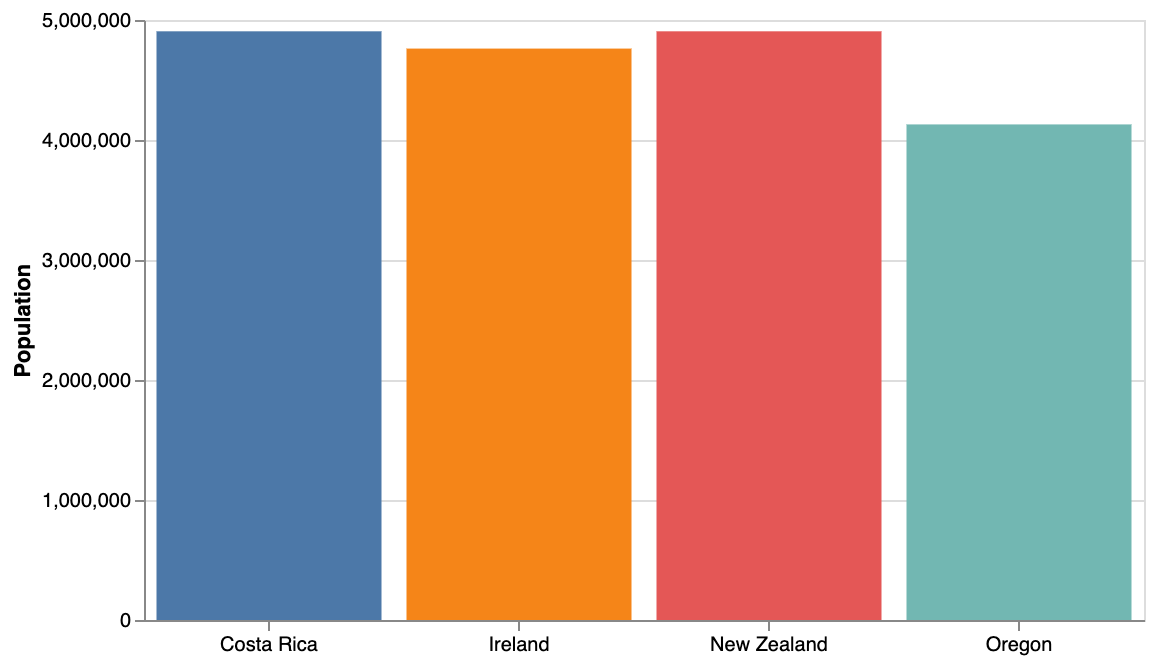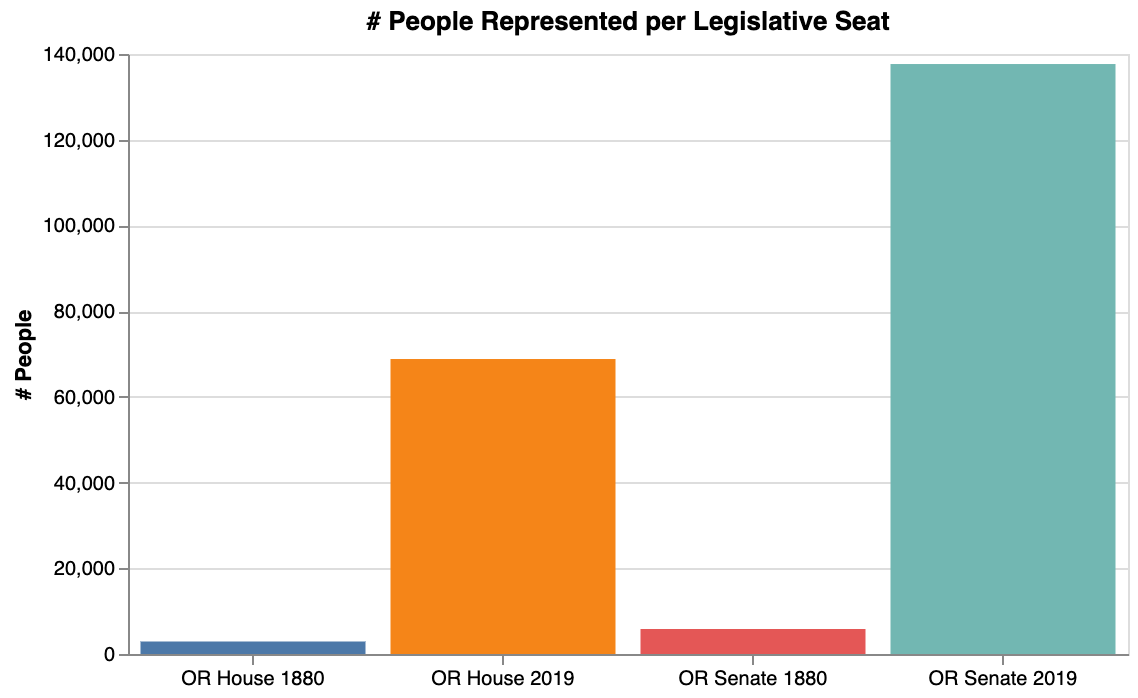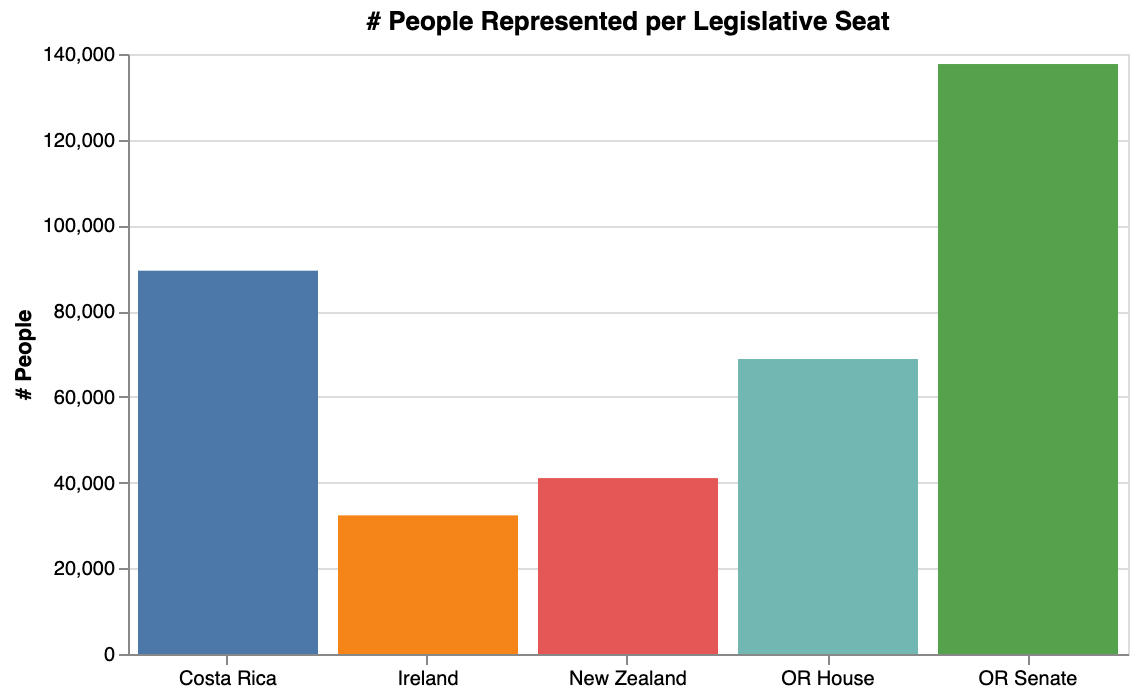Growing Oregon's Leadership
As the dust has finally settled from the November elections, I feel like now is a good time to take stock and see how our elections and systems of government could be improved. I have a lot of thoughts, but I want to first think about what representation means in Oregon, and how we might change it for the better.
Who do you represent?
Let's get back to basics. According to the latest 2019 ACS data, Oregon has a population of 4.1 million people. To compare us to other countries, we might look at Ireland (pop. 5.1M), Costa Rica (pop. 5M), or New Zealand (4.9M).

Figure 1: Sources: 2019 ACS and CIA World Fact Book
How many people should one person represent in a democracy? Ten thousand? Fifty thousand? A million? Try to take a moment and pick a number in your head for how many constituents you could realistically serve as a representative.
Now, let's take a look at Oregon's government. With 60 House districts and 30 Senate districts, each house member represents about 69,000 constituents and each senator represents about 137,000. How does that compare to your number? Higher? Lower?
In case you were wondering, the number of house and senate representatives has not changed since 1880, back when the state had a population of just 175,000. In 1880, each house member represented just 2,900 people, and each senator represented 5,800 constituents. (Note: the 1880 Census estimate did not count indigenous peoples, and possibly only counted the white population, given Oregon's history of white supremacy).

Figure 2: Source: U.S. Census, Oregon Legislature
To put this in perspective, Ireland's Dáil Éireann "lower house" has 160 representatives, meaning each member represents just 32,000 constituents. New Zealand's 120-seat parliament gives one representative for every 41,000 people. Costa Rica is the outlier, with only 57 seats in their parliament, delivering a representative for every 89,000 – which is still 41,000 less people than the number of people each Oregon senator represents.

Figure 3: Source: CIA World Fact Book
Of course, we should ask: does representing fewer constituents actually produce better results?
The Walk-Out
For those who don't remember much of 2019, it can be easy to forget just how contentious the legislative session was this past year. With the Democrats holding a super-majority, Republican Senators walked out of the legislative session – twice, threatened State Troopers, then proceeded to come back to pass over 100 bills in less than 48 hours after a vaccine requirement for public school students and carbon cap-and-trade billed were swept from the docket. Then, in 2020, senators and house members skipped town again. It has been, shall we say, a pretty exciting time for democracy in Oregon.
How does that compare to New Zealand, Ireland, or Costa Rica? According to the The Economists Democracy Index, New Zealand and Ireland consistently score in the top 10 democracies in the world, with scores of 9.26 and 9.24, respectively. While Costa Rica has a score of 8.13, that still places it in the top 20 – above France, Portugal and Chile. In comparison, the United States scores a 7.96 and is considered a "flawed democracy."
So what are some reasons that these countries about the size of Oregon are not only capable of maintaining a legislature that meets every year, but also manage to achieve nearly 100% renewable energy, deliver universal healthcare at half the cost of the US, and actively debate a universal basic income?
Better Together
The United State's systems of government is split into two bodies: the House and the Senate. This is modeled on the British parliament, with a House of Commons and the House of Lords. The Senate was created as a bargaining chip to win over Southern states into the union, which lacked the white-male population to the north, but wanted outsized representation in return for the economic powerhouse that was slave-based agriculture (for those interested, check out Colin Woodard's American Nations). The Senate/House system was replicated across each state.
Before the 1960's rulings of Baker v. Carr and Reynolds v. Sims, each county appointed a senator, no matter whether that county was 800 people or one million, giving outsized influence to rural counties and less to the growing cities and suburbs. After the Supreme Court's decision that this practice violated the 14th amendment, all legislative districts were to give equal representation for every person ("one person, one vote"). These rulings lead to redistricting of state senates to ensure each district had the same population, which meant each state senate became just another version of the state's house.
In a smaller state like Oregon, while our legislature is split into two bodies, they tend to act as a unicameral one. Most of our committees already have both Senate and House representatives to avoid having duplicate committees. While some House members tend to be a bit more radical, the ideological center certainly leans left in both bodies. Due to the Democratic super-majority, the governor, house and senate act as a unicameral government, preventing Republicans from making sweeping changes to proposed legislation.
In the cases of our example countries, New Zealand, and Costa Rica have unicameral governments, or a single legislative body. Only Ireland has a second "upper house," but the representatives are special appointees and only have the ability to veto legislation, not introduce new bills. Only one state in the union has a unicameral legislature: Nebraska. This was lead by George Norris back in the 1930's following the great depression. Norris touted that a unicameral legislature would cut costs, reduce corruption from lobbying interests, and bring greater accountability and transparency to the legislative process. A short but intense campaign put a constitutional amendment on the ballot in 1934 which passed with overwhelming margin, despite major opposition from nearly every Nebraskan legislator and newspaper. Today, Nebraska's 49 seat Senate means each senator represents about 39,000 people.
So why does Oregon continue to maintain a second legislative body? For one, legislators will never vote to kick themselves out of office. We could solve that political problem, and the very real problem of too few representatives, by combining the two legislative bodies.
Growing Our Leadership
To improve representation and deliver a more streamlined government, Oregon should examine merging the House and Senate into a single unicameral legislative body. While doing so, we should expand the number of seats to keep a ratio of people to representative to around 1:40,000, which would lead to about 101 seats in the new "Oregon Parliament". This may seem like a lot, but keep in mind we've had the same number of representatives since 1880, when each senator represented just 5,800 people.
But would this really avoid the same polarization that is going on across our state and our country? We'll save that for another entry in my series on reforming Oregon's democracy.